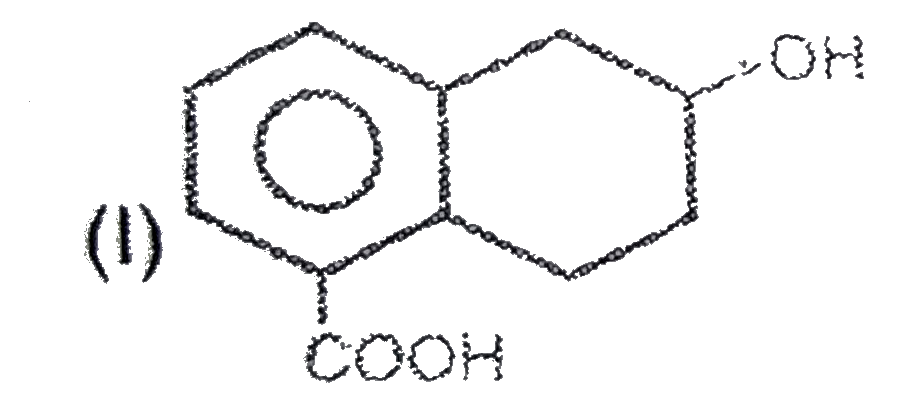The following two conpound I and II can be distinguished by using reagent:

(p) aq. NaHCO3 ltBrgt (Q) Nerutral FeCl3
( R ) blue litmus solution
(S) Na metal
(T) HCL/ZnCl2anhydrous
P or R
Q or T
S or T
R or S
The correct Answer is:b
Step by step video, text & image solution for The following two conpound I and II can be distinguished by using reagent: (p) aq. NaHCO_(3) ltBrgt (Q) Nerutral FeCl_(3) ( R ) blue litmus solution (S) Na metal (T) HCL/ZnCl_(2) anhydrous by Chemistry experts to help you in doubts & scoring excellent marks in Class 12 exams.
Topper's Solved these Questions
- BOOK - GRB PUBLICATIONCHAPTER - BIOMOLECULES, POLYMERS, PRACTICAL ORGANIC CHEMISTRY AND CHEMISTRY IN DAILY LIFEEXERCISE - REASONING TYPE27videos
BIOMOLECULES, POLYMERS, PRACTICAL ORGANIC CHEMISTRY AND CHEMISTRY IN DAILY LIFE
- BOOK - GRB PUBLICATIONCHAPTER - BIOMOLECULES, POLYMERS, PRACTICAL ORGANIC CHEMISTRY AND CHEMISTRY IN DAILY LIFEEXERCISE - MULTIPLE OBJECTIVE TYPE72videos
BIOMOLECULES, POLYMERS, PRACTICAL ORGANIC CHEMISTRY AND CHEMISTRY IN DAILY LIFE
- BOOK - GRB PUBLICATIONCHAPTER - ALCOHOLS AND ETHERSEXERCISE - level 621videos
ALCOHOLS AND ETHERS
- BOOK - GRB PUBLICATIONCHAPTER - CARBOXYLIC ACID AND DERIVATIVES, AMINES AND OTHER NITROGEN COMPOUNDSEXERCISE - Subjective type19videos
CARBOXYLIC ACID AND DERIVATIVES, AMINES AND OTHER NITROGEN COMPOUNDS
Similar Questions
How may of the following reagents can be used to distinguish between hex-1-yne and hex-2-yne?
(a). CuCl/NH3
(b). AgNO3/NH3
(c). Na metal
(d). Neutral FeCl3
(e). Fehling's reagentView SolutionThe following two compounds I and II can be distinguished by using reagent

(a) aq. NaHCO3 " " (b) Neutral FeCl3
(c ) Fehling solution " " (d) Na metalView Solution
Knowledge Check
- Question 1 - Select One
The following two compounds I and II can be distinguished by using reagent
 " "
" " 
(a) aq. NaHCO3 " " (b) Neutral FeCl3
(c ) Blue litmus solution " " Na metal " " (e) HCl/ZnCl2 anhydrousAa or cBb or eCd or eDc or d - Question 2 - Select One
The following two compounds I and II can be distinguished by using reagent

(a) aq. NaHCO3 (b) Neutral FeCl3
(c) Blue litmus solution (d) Na metal
(e) HCl/ZnCl2 anhydrousAa or cBb or eCd or eDc or d - Question 3 - Select One
The following two compounds I and II can be distinguished by using reagent

(a) aq. NaHCO3 (b) Neutral FeCl3
(c) Blue litmus solution (d) Na metal
(e) HCl/ZnCl2 anhydrousAa or cBb or cCc or dDb or d
The following two compounds I and II can be distinguished by using reagent

(1)Aq.NaHCO3 , (2)Neutral FeCl3(aq.)(FeCl3+NH4OH+H2O)
(3)Blue litmus solution , (4)Na metal
(5)HCl+ZnCl2(anhydrous)View SolutionAcetaldehyde and propyne can be distinguish by
(i) Tollen's reagent (ii) I2/NaOH (iii) Lucas reagent (iv) neutral FeCl3View SolutionAcetaldehyde and Propyne can be distinguish by :
(i) Tollen's reagent " " (ii) l2/NaOH " " (iii) Lucas reagent " " (iv) neutral FeCl3View SolutionCompounds I and II can be distinguished by using reagent.
(I) -4-Amino-2-methylbut-3-en-ol
(II) -4-Amino-2,2dimethylbut-3-yn-1-olView SolutionCompounds I and II can be distinguished by using reagent.
I II4-Amino-2methylbut-3-en-2ol4-Amino-2,2-dimethylbut-3-yn-1-olView Solution
